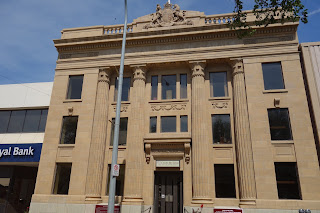Marked on a map as "Moose Jaw Bone Creek" in an 1857 survey, two theories exist today as to how the town got its name. The first is it comes from the Plains Cree name moscastani-sipiy meaning "a warm place by the river", indicative of the protection from the weather the Coteau range provides to the river valley containing the town and also the Plains Cree word moose gaw, meaning "warm breezes". The other is on the map of the city, the Moose Jaw River is shaped like a moose's jaw.
A snowbird aerobatic jet and "Mac the Moose" mark the entrance into Moose Jaw:
Only one remains now, but originally there were two of these "wedding cake houses" in Moose Jaw
The Moose Jaw railway station was built by the Canadian Pacific Railway from 1920-1922 and was designated a historic railway station in 1991
The original Royal Bank of Canada building, built in 1914, now law offices
Built between 1911-1914 Moose Jaw City Hall was originally built for the Government of Canada to house a post office, Royal Canadian Mounted Police station and other government offices.
This building was originally planned in 1913 but WW1 delayed construction, so the Grand Opening of the Capitol Theatre didn't occur until 1916 when it was the largest theatre in Saskatchewan.
William Grayson, who came to Moose Jaw in 1883, was the town's largest land owner when he had this house built in 1911
Completed in 1909, the historic Moose Jaw Court House is the oldest continuously functioning provincial court house in Saskatchewan. The building has been designated a National Historic Site of Canada.
Zion United Church on the left and beside it the Grant Hall Hotel. The church building was constructed in 1906-07 and is the only remaining church of this particular design in Western Canada. The Grant Hotel was built in 1927 and although Moose Jaw was a major CPR divisional point since its inception, Moose Jaw lacked a grand railway hotel. The Grant Hall Hotel became known in this capacity and to this day it still functions as a boutique hotel.
Central Collegiate, one of the oldest operating public schools in Saskatchewan was built in 1909
Built in 1907 there are some very interesting stories about why St. Joseph's church only has one steeple.
One thing that I could take lots of photos of though were the murals in Moose Jaw. Approximately 50 murals depicting Moose Jaw's early history can be found on the sided and front of buildings throughout the town's downtown core. Paintings, glass works, and a bas-relief all provide insight into the development of Moose Jaw. Here's just a sampling...there are many more:
"Canada Mosaic 150"
This unique mural is composed of 828 tiles painted by Moose Jaw residents, and honouring the Snow Bird flying team. For Canada's 150th, 150 communities across Canada have created a mural that reflects the history and culture of Canada. This mural, and all the others, represent a train car, and eventually all the murals will be joined together to form a gigantic train-the foundation of the unification of Canada. The mural will be a historic legacy to celebrate Canada's Sesquicentennial. You can view the whole train online at: http://canada150mosaic.com/
"History CPR Station"
"For the Veterans"
The mural was created to honour all the Veterans who fought, and are still fighting to provide us with the freedoms we enjoy and take for granted. The work depicts the profile of a war-era female nurse, a sailor, an infantryman, and an airman.
"Old Time Threshing Bee"
A tribute to the farmers who made the prairies the bread basket of the world.
"Air Force Blue"
A Tribute to the training of pilots at the Base since 1940 to date.
"Cruising Main Street"
A lively scene of Moose Jaw's Main Street in the '20s. It is painted on the back of the old Capitol Theatre and some of the elements of the theatre are incorporated in the design. Two of the people, one in the window and the worker at the side of the mural, are actually sculptures sticking out from the wall.
"The First Run"
On August 19, 1911 Moose Jaw's streetcar took its first run.
"The Last Dambuster"
Born in Moose Jaw, Flt. Sergeant Ken Brown was the last surviving pilot of those who flew the "Dambuster Raid" of WWII. He was only the second Canadian ever to be awarded the prestigious CGM for his efforts.
"Breaking New Ground"
Representing the pioneer's hopes of a golden future by "proving his land", 5 acres per year for 5 years to obtain title of ownership.
"Discovery"
Consisting of 750 hand made clay tiles, this mural depicts images of advancement in communication.
"Tribute to the Metis Community"
"Living With The Land"
Paying honour to the Lakota, Cree, Assiniboine, Metis and other first nation people who made camp at The Turn, in Moose Jaw Valley.
There is no doubt that Moose Jaw is indeed an epi-centre for railway trains in Saskatchewan, I could hear the train whistles blowing the whole time I was there. When I saw this I had to ask someone if it is indeed an active line today - and "yes" was the answer, twice a day. Imagine that - right beside the road and right beside your front yard!
Railway bridge over the Moose Jaw river



























No comments:
Post a Comment